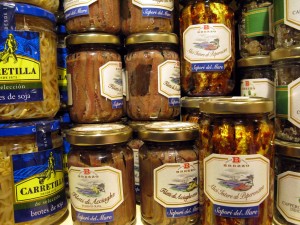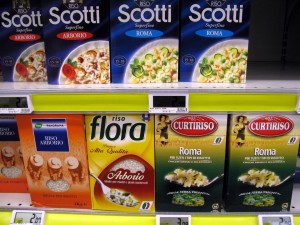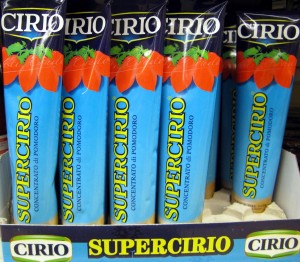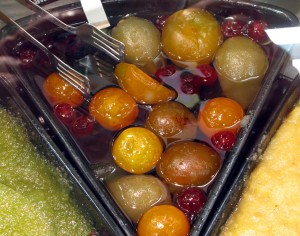Since so many of the regional Italian cuisines are based on food that is fresh, fresh, fresh, we’re limited in what we can bring back home. But there are some dry goods and conserves that turn out to be very useful in cooking Italian dishes. We’ve learned not to bother with colored pastas, which cook up to a gray mess anyway, because we can buy good imported dry pasta for about the same price we’d pay for it in Italy.
Here’s our Italian grocery list:
 Anchovies.
Anchovies.
Many Americans think they don’t like anchovies because they have never tasted good ones used with the restraint characteristic of Italian recipes. We look for anchovies packed in glass jars so we can make sure they are firm and whole. We also check the jar for an expiration date several months in the future.
Dried mushrooms.
Dried fungi, especially dried porcini mushrooms, are central to a number of pastas and risottos. Alas, purchasing in an Italian market doesn’t provide much of a price break over buying in US gourmet import stores, but because Italian cooks use a lot of dried mushrooms, the shelf stock is always fresh. Even dry, porcini should remain flexible.
 Rice.
Rice.
We buy arborio for most risottos, but always get some vialone nano for seafood risottos, and Roma for Roman rice dishes. They’re all strains of short-grained, oval rice. The less expensive riso originale (the more generic mother strain) is a good choice for soups or arancini, but we rarely buy it unless we have a lot of room left in the suitcase. The same one-kilo box of vialone nano we buy in Italy for two euros is nearly $15 in the U.S.
Bouillon cubes.
Bouillon cubes and soup bases differ from country to country-even the international brands like Knorr. Those sold in the Italian markets are seasoned to Italian taste, and work very well as a backup for having your own homemade stock. We like the Starr brand, especially the porcini mushroom bouillon cubes.
Mushroom salad.
Jarred marinated mushrooms provide an instant antipasto. We generally look for mixed “woods” mushrooms for variety of colors and shapes. Fior di Bosco is a good choice.
 Tomato paste in a tube.
Tomato paste in a tube.
Often ridiculously expensive at home, the tubes of double-concentrated Italian tomato paste are a perfect solution for providing just a touch of tomato to a soup or a sauce. The flavor is typically richer and a little sweeter than canned tomato paste.
Herbs.
There are few dried herbs used in Italian cooking that we can’t buy at home, but we like the aromatic sweetness of Italian oregano for seasoning sauces and salads.
Salt.
Like the Spaniards, the Italians typically use sea salt to season their food, though their salt is usually more refined than the Spanish. Italian processed sea salt is usually found in both fino and grosso (fine and coarse). The coarse salt is intended for oven-roasting fish or meat, but can do double duty in a salt grinder.
 Mostarda de la Cremona.
Mostarda de la Cremona.
The great cookbook author (and all-around generous soul) Michele Scicolone turned us on to this conserve of small fruits poached in sugar syrup until they become nearly translucent. A secondary seasoning with mustard syrup gives the mostarda a sweet-savory quality similar to a chutney, but even more beautiful to serve with a bollito misto (a ring of mixed meats). You can buy it in bulk at deli counters as pictured, but mostardas are also sold in jars (easier to take home).
